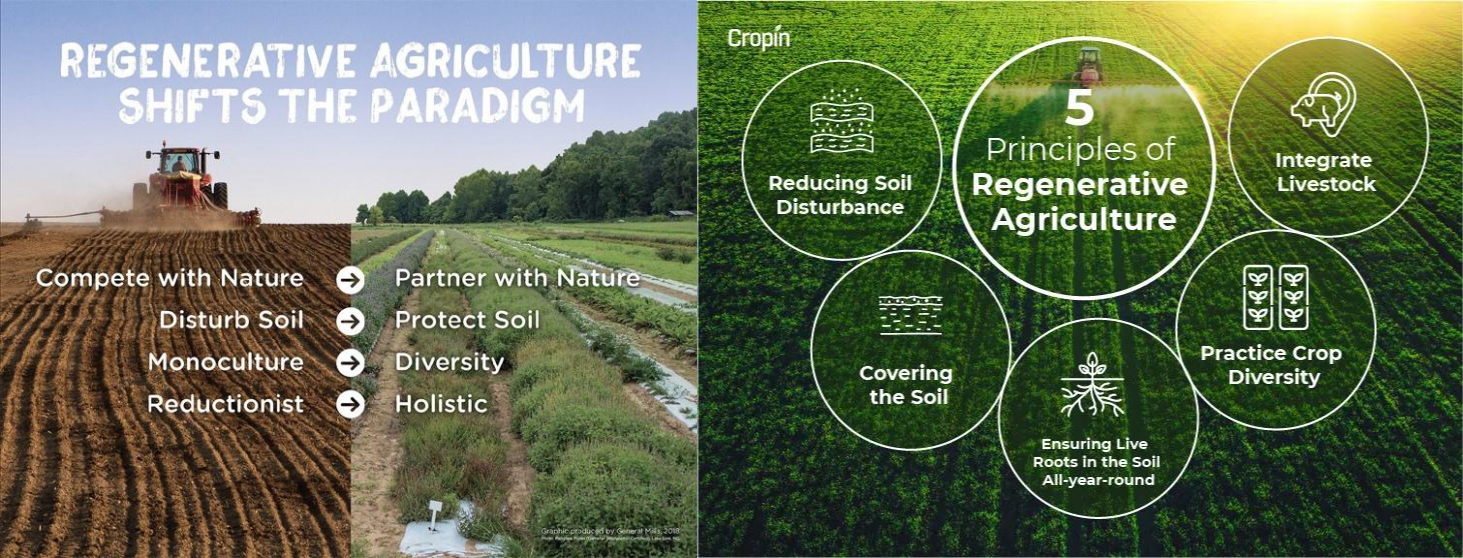What is regenerative agriculture?
Regenerative Agriculture is quite simple: it is any form of farming, i.e. the production of food or fibre, which at the same time improves the environment. This primarily means regenerating the soil. It’s a direction of travel, not an absolute.
Regenerative agriculture is a conservation and rehabilitation approach to food and farming systems. It focuses on topsoil regeneration, increasing biodiversity, improving the water cycle, enhancing ecosystem services, supporting biosequestration, increasing resilience to climate change, and strengthening the health and vitality of farm soil.
It is a method of farming that “improves the resources it uses, rather than destroying or depleting them,” according to the Rodale Institute.
HOW DOES IT WORK?
Regenerative agriculture is centered around universal agronomical principles that help protect and restore natural resources – primarily soil, as well as water and biodiversity.
PRINCIPLES
1. Don’t disturb the soil: Soil supports a complex network of worm-holes, fungal hyphae and a labyrinth of microscopic air pockets surrounded by aggregates of soil particles. Disturbing this, by ploughing or heavy doses of fertilizer or sprays will set the system back.
2. Keep the soil surface covered: The impact of rain drops or burning rays of sun or frost can all harm the soil. A duvet of growing crops, or stubble residues, will protect it.
3. Keep living roots in the soil. In an arable rotation there will be times when this is hard to do but living roots in the soil are vital for feeding the creatures at the base of the soil food web; the bacteria and fungi that provide food for the protozoa, arthropods and higher creatures further up the chain. They also keep mycorrhizal fungi alive and thriving and these symbionts are vital for nourishing most plants and will thus provide a free fertilizing and watering service for crops.
4. Grow a diverse range of crops: Ideally at the same time, like in a meadow. Monocultures do not happen in nature and our soil creatures thrive on variety. Companion cropping (two crops are grown at once and separated after harvest) can be successful. Cover cropping, (growing a crop which is not taken to harvest but helps protect and feed the soil) will also have the happy effect of capturing sunlight and feeding that energy to the subterranean world, at a time when traditionally the land would have been bare.
5. Bring grazing animals back to the land: This is more than a nod to the permanent pasture analogy, it allows arable farmers to rest their land for one, two or more years and then graze multispecies leys. These leys are great in themselves for feeding the soil and when you add the benefit of mob-grazed livestock, it supercharges the impact on the soil.
BENEFITS
Regenerative Agriculture Is Focused on Increasing Soil Health: No matter the variation in regenerative agricultural practices, all focus on increasing soil health. According to the Regeneration International, a non-profit organization with the goal for a global transition to agriculture and land management, “Regenerative agriculture describes farming and organic practices that, among other benefits, reverse climate change by rebuilding soil organic matter and restoring degraded soil biodiversity…” By focusing on building soil health, you can optimize their yield results and crop health naturally.
Maintaining Crop yields is a no brainer: No conversation around switching regenerative agricultural practices would be complete without addressing yield. According to the Nature Conservancy Organization, regenerative agricultural practices “reduce the risk of yield loss due to stressors, and can bring about a material increase in crop yields and quality.”
Growing more resilient crops: According to the Rodale Institute, yields “under organic systems are likely to be more resilient to extreme weather… in the long-running Farming System Trial, in drought years, yields were consistently higher in the organic system. For instance, organic corn yields were 28-to-34% higher than conventional.” In general, having resilient crops comes back to the soil and increasing soil biodiversity. By ensuring your soils are healthy and teeming with beneficial soil microbes, you can naturally displace and suppress disease.
Infiltration and biodiversity: Regenerative farming has other demonstrable benefits besides improving soil health and helping to fight climate change. Improving the soil not only increases fertility in a sustainable way but also tends to improve water infiltration. Better infiltration means less runoff, and also less erosion and pollution from the soil being carried away in the runoff water. In some areas, water springs that dried up several years ago have begun to flow again due to new regenerative farming approaches.
Increased climate-friendliness: In the 21st-century conventional agriculture incurs other indirect costs that cannot be ignored. The long-term threat of climate change to the natural environment is well established, and agriculture bears much of the responsibility for this Conversely, regenerative agriculture seeks to increase the organic matter in the soil, which makes it better able to sequester carbon from the atmosphere, meaning it has the potential to reduce climate change instead of contributing to it. Organic farming is friendlier to the climate because it stores carbon in healthy soil, and reduces energy requirements by relying more on physical and animal labor rather than fossil fuels. It eliminates the use of petroleum-based fertilizers and pesticides and supports natural ecosystems that store carbon, such as forests and prairies. Lastly, it reduces the production of greenhouse gases due to a reduction in fossil fuel use.
Reduced costs: Employing regenerative agricultural methodologies means that you don’t have to spend money on artificial fertilizers because the soil is healthy and replenishes itself. Additionally, you don’t have to invest in expensive herbicides and pesticides because the farm is a more robust ecosystem that can tolerate disturbances by invasive or competing species.
Healthier yields: It goes without saying that the healthier the soil, the healthier the crop yield. When plants have the nutrients and root systems they need to thrive, they build compounds to help protect against insects and disease. There is also growing evidence that a healthy soil microbiome full of vital bacteria, fungi, and nematodes is more likely to produce nutrient-dense food, promoting better human health.
Specialization opportunities: Conventional farming practices focus on the growth of a specific commodity crop. Through organic farming practices, there are more opportunities to specialize. This is because you and your farming practice will grow crops that are most suited to the soil composition available to you.
➢ Increased farmland utilization.
➢ Using your land more efficiently.
➢ Diversifies farm income and increases farm viability.
➢ Increases crop resistance.
➢ Greater nutrient density in plants.

